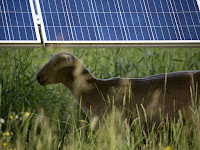Declining costs have helped some of the country's smallest electricity providers expand their use of solar in highly innovative ways.
A five-year effort by electric cooperatives to expand the use of solar energy in rural parts of the United States is coming to a successful conclusion.
Under the Solar Utility Network Deployment Acceleration (SUNDA) program, which was run by the National Rural Electric Cooperative Association (NRECA) under a cost share arrangement with the U.S. Energy Department, rural electric co-ops are on track to own or buy 1 gigawatt of solar power generation capacity by 2019.
As of April, more than 120 co-ops had at least one solar project on line. Of those, half said they have plans to add more solar generating capacity.
The accomplishment is no small feat. The consumer-owned structure of co-ops means that they can’t make direct use of federal tax credits, which have helped to spur solar adoption among investor-owned utilities. Co-ops often have had to come up with innovative financing arrangements to make the numbers work. In particular, solar adoption has benefited from big drops in the cost of solar PV cells in recent years.
Read more at As Economics Improve, Solar Shines in Rural America

No comments:
Post a Comment